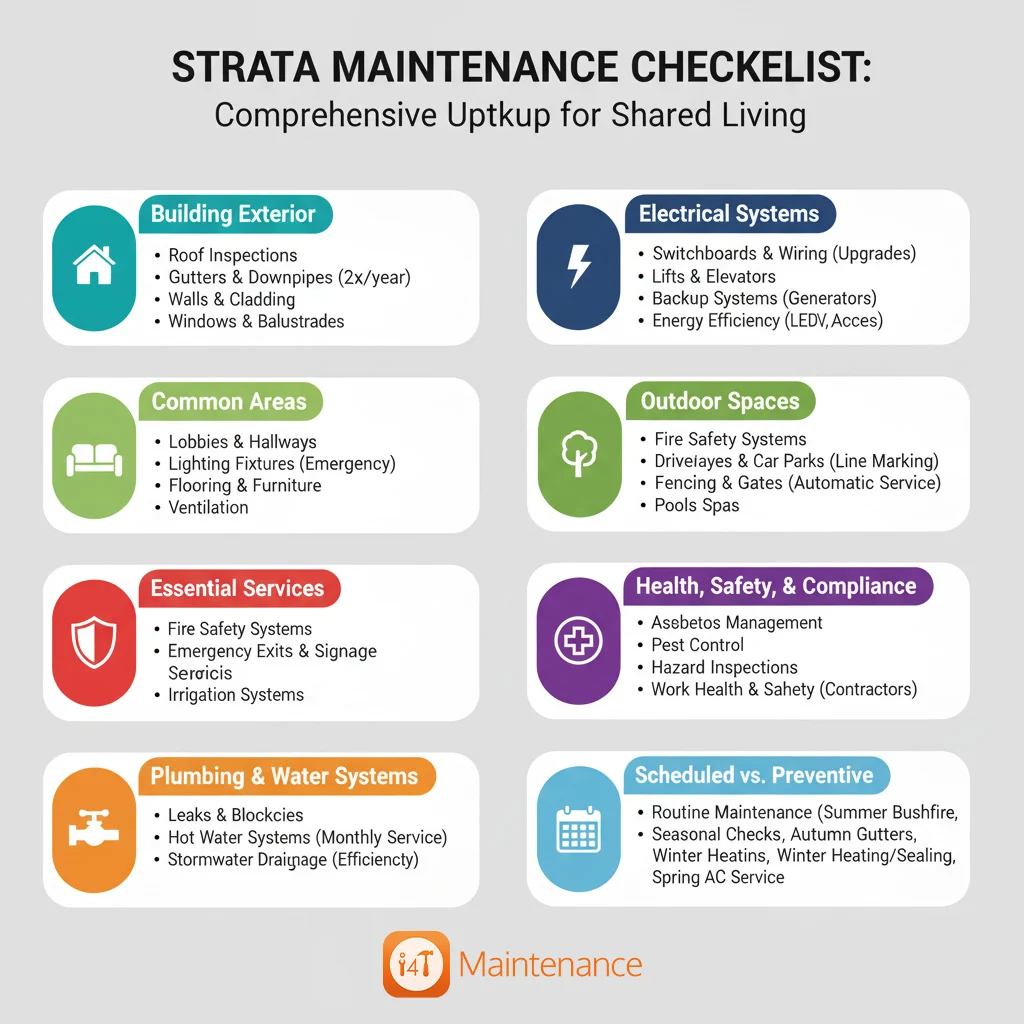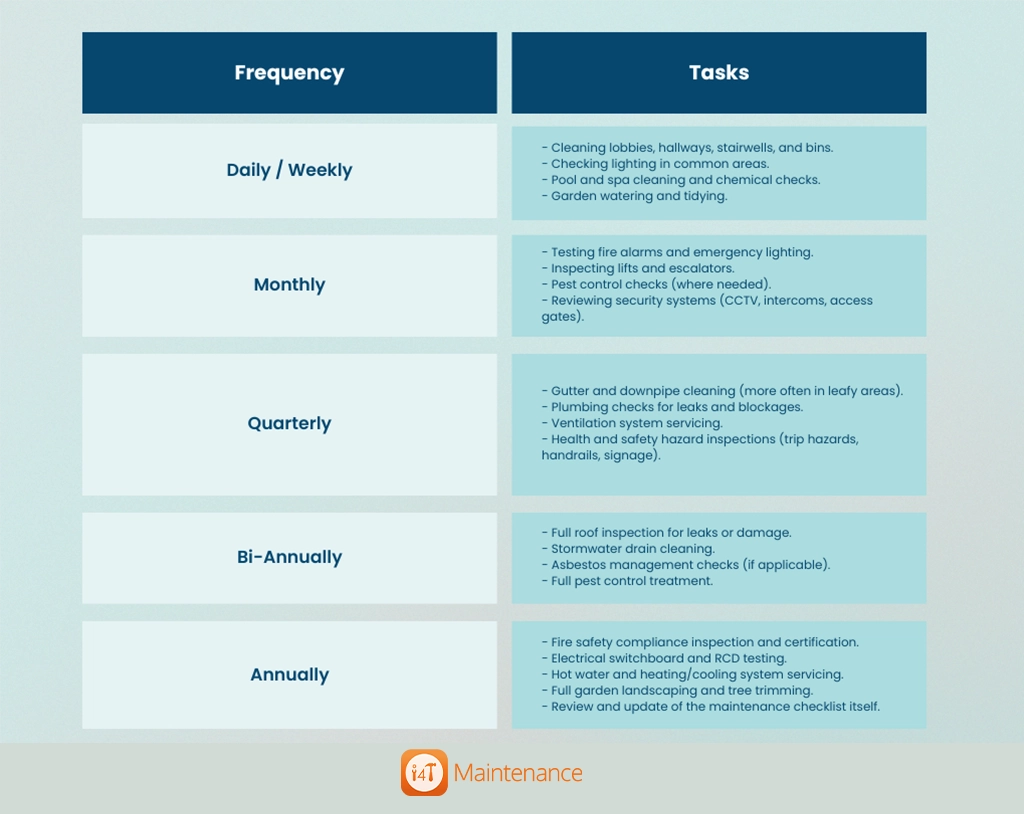Strata living has become a big part of life in Australia, especially in our busy cities, where apartments and townhouses are the norm. With so many people sharing the same spaces, from lobbies and gardens to lifts and car parks, keeping everything in top shape is no small job. That’s where a strata maintenance checklist comes in handy.
Think of it as a simple guide that helps strata managers, committees, and even residents stay on top of what needs to be done, when it needs doing, and who should be responsible. Without one, important tasks can slip through the cracks, leading to costly repairs, safety issues, and unhappy residents.
In this article, we’ll break down what should be included in a strata maintenance checklist, why it matters, and how it can make strata living smoother and stress-free for everyone.
Why a Strata Maintenance Checklist is Essential
A well-prepared strata makes life easier for everyone who lives, works, or manages the property. Here’s why it’s so important:
- Saves money in the long run – Spotting small problems early, like a leaking pipe or cracked tiles, prevents them from turning into expensive repairs later.
- Keeps residents safe and happy – Regular checks on things like fire alarms, lighting, and walkways mean fewer accidents and a more comfortable place to live.
- Helps meet legal and compliance requirements – Strata properties need to follow strict safety and building standards. A checklist ensures nothing is overlooked.
- Makes budgeting easier – Predictable maintenance costs are much simpler to plan for than unexpected emergencies.
- Protects property value – A well-maintained building looks good, runs smoothly, and keeps its market value strong.
A checklist gives strata managers and committees peace of mind, knowing they’re staying proactive rather than scrambling to fix last-minute issues.
Key Areas to Cover in a Strata Maintenance Checklist

Every strata property is unique, but most share similar systems, structures, and communal areas that need regular upkeep. A good checklist ensures nothing is forgotten, no matter how small. Here’s a detailed breakdown:
a. Building Exterior
The outside of your building is the first thing residents and visitors see, and it’s also the first line of defence against weather and environmental wear.
- Roof inspections: Look for cracked or missing tiles, rust on metal roofing, or damage to flashing. Small leaks can quickly lead to structural water damage if not fixed.
- Gutters and downpipes: Blocked gutters cause flooding, water staining, and damage to foundations. Cleaning them at least twice a year, especially after autumn leaf fall, prevents expensive problems.
- Walls and cladding: Inspect for cracks, bubbling paint, or signs of water seepage. Repainting and resealing not only protect but also keep the property looking fresh.
- Windows and doors: Check seals, locks, and hinges. Draughts or leaks often start with poorly maintained windows.
- Balconies and balustrades: These are safety-critical areas. Inspections ensure they meet Australian building standards and aren’t corroding, cracking, or coming loose.
b. Common Areas
Shared spaces need to be safe, welcoming, and functional.
- Lobbies and hallways: Regular cleaning and touch-ups keep them presentable. Scuffed walls, cracked tiles, or stained carpets send the wrong impression.
- Lighting fixtures: Dark stairwells or corridors are safety hazards. Test emergency lights to ensure they work in blackouts.
- Flooring: Trip hazards can cause injuries and liability claims. Carpets should be vacuumed often, while tiles may need anti-slip treatments.
- Furniture and fittings: Sofas, benches, or tables in shared lounges should be checked for damage. Wobbly furniture can easily injure someone.
- Ventilation: Poor airflow leads to mould and health complaints. Test exhaust fans and ensure vents aren’t blocked.
c. Essential Services
These systems are vital for safety and compliance.
- Fire safety systems: Strata law requires regular checks of alarms, sprinklers, extinguishers, and hydrants. Fire doors must shut properly and remain clear of obstructions.
- Lifts and elevators: Residents rely on them daily. A checklist should include monthly servicing, safety checks, and immediate attention to breakdowns.
- Emergency exits and signage: Signs must be visible, illuminated, and compliant with regulations. Exits should remain unlocked and clear.
- Security systems: CCTV cameras, swipe access points, and intercoms should be tested regularly to keep residents safe and prevent vandalism.
d. Plumbing and Water Systems
Water issues can escalate quickly if not managed properly.
- Leaks and blockages: Even small leaks can waste thousands of litres of water and cause mould. Toilets, taps, and under-sink pipes need regular checks.
- Hot water systems: Central systems must be serviced to avoid breakdowns that leave residents without hot water.
- Stormwater drainage: Heavy rains test the capacity of drains. Blockages here can cause flooding in car parks and basements.
- Irrigation systems: Broken sprinkler heads or faulty timers waste water and increase bills.
e. Electrical Systems
Faulty electrical systems are not only inconvenient but also dangerous.
- Switchboards and wiring: Older properties may still have outdated wiring that needs upgrading to meet current standards.
- RCD testing: Residual Current Devices save lives by shutting off faulty circuits. Testing them regularly ensures they work when needed.
- Backup systems: In larger buildings, generators or battery systems keep essential services like lifts and lighting running during blackouts.
- Energy efficiency upgrades: Replacing halogen lights with LEDs or adding solar panels reduces costs and appeals to eco-conscious residents.
f. Outdoor Spaces
Well-kept outdoor areas boost both safety and resident satisfaction.
- Gardens and landscaping: Overgrown plants can block pathways or reduce visibility, making areas unsafe at night. Regular pruning, mulching, and lawn care keep them tidy.
- Driveways and car parks: Potholes and uneven surfaces pose risks to cars and people alike. Line markings should be refreshed for clarity.
- Fencing and gates: Ensure they open and close properly and aren’t rusting or leaning. Automatic gates need servicing to avoid sudden breakdowns.
- Pools and spas: These require strict compliance with health and safety laws, including regular water testing, cleaning filters, and checking barriers and signage.
g. Health, Safety, and Compliance
Ignoring compliance obligations can lead to hefty fines and legal issues.
- Asbestos management: Older buildings may still have asbestos materials. A register and safe handling procedures are essential.
- Pest control: Cockroaches, rodents, and termites can cause health issues and structural damage. A scheduled pest treatment plan keeps them at bay.
- Hazard inspections: Slippery tiles, broken steps, or loose handrails are common hazards. Spotting them early avoids accidents and insurance claims.
- Work health and safety: Contractors working onsite must follow WHS standards, including proper licensing and insurance.
h. Scheduled vs. Preventive Maintenance
It’s not just about fixing problems; it’s about preventing them.
- Routine maintenance: Includes daily or weekly cleaning, garden care, bin collection, and light checks.
- Preventive checks: These catch problems early, like inspecting roof membranes before storm season or flushing hot water systems to prevent corrosion.
- Seasonal tasks: For example:
- Summer: Bushfire safety prep (clearing gutters, removing flammable debris).
- Autumn: Extra gutter cleaning to handle falling leaves.
- Winter: Checking heating systems and sealing draughts.
- Spring: Servicing air-conditioning and refreshing gardens.
- Summer: Bushfire safety prep (clearing gutters, removing flammable debris).
A checklist that covers all these areas ensures nothing is left to chance, making strata living safer, more enjoyable, and more cost-effective.
How Often Should Maintenance Tasks Be Done?
Not all maintenance tasks need to be done every week. Some require daily attention, others only once or twice a year. The trick is to set up a schedule that keeps everything running smoothly without wasting money or effort.

Benefits of a Well-Structured Checklist
A strata maintenance checklist is a powerful tool that keeps the whole community running smoothly. When it’s done properly, here’s what you can expect:
- Peace of mind for everyone: Residents know the property is safe, clean, and well looked after. Strata managers can rest easy knowing nothing important is being missed.
- Clear responsibilities: A checklist makes it easy to assign jobs to contractors, cleaners, and service providers. No confusion, no finger-pointing.
- Transparency and trust: When tasks are documented and tracked, owners and tenants can see exactly what’s being done and when. This builds confidence in the strata committee.
- Fewer surprises: Regular maintenance prevents emergencies. Instead of dealing with sudden breakdowns or costly repairs, everything runs on a predictable schedule.
- Financial savings: Preventive maintenance always costs less than reactive repairs. A $200 gutter clean today could save thousands in water damage down the track.
- Improved property value: A well-maintained building looks appealing, attracts buyers and renters, and protects long-term investment value.
A good checklist helps strata managers run the property smoothly, keeps residents happy, and saves money at the same time. It’s a win-win for everyone.
Tips for Creating and Managing a Strata Maintenance Checklist
A strata maintenance checklist works best when it’s simple, organised, and tailored to your property’s needs. Here are some practical tips to make yours effective:
- Keep it clear and easy to follow
Avoid making the checklist too complicated. Use plain language, group tasks by area (e.g. exterior, plumbing, gardens), and keep it user-friendly for managers, contractors, and even residents. - Prioritise the essentials
Not all maintenance tasks are urgent. Focus on safety, compliance, and high-use areas first. This ensures limited budgets and resources are used where they matter most. - Use professional input
Bring in licensed contractors for specialised areas like fire safety, lifts, and electrical systems. Their expertise ensures tasks are done to standard and nothing critical gets overlooked. - Make it a living document
A good checklist isn’t “set and forget.” Review it regularly, update it after major works, and adapt it as the building ages or resident needs change. - Involve residents and owners
Encourage feedback from the people living there. They often spot issues (like a flickering light or dripping tap) before anyone else. Having a reporting system makes the checklist more complete. - Go digital for efficiency
Paper checklists can get lost or outdated. Digital tools make it easier to schedule tasks, set reminders, track progress, and keep records. This also improves transparency, since reports can be shared instantly with committees and owners. - Track budgets alongside tasks
Linking maintenance tasks with budget allocations helps committees plan ahead. Knowing when big expenses are due—like repainting or roof repairs—means fewer financial shocks.
With these tips, your checklist won’t just be another document sitting in a folder. It’ll be a practical, everyday tool that helps your strata community stay safe, compliant, and well-maintained.
Common Mistakes to Avoid
Even with the best intentions, some strata managers and committees fall into common traps when it comes to maintenance. Here are the big ones to watch out for:
- Ignoring small repairs
A dripping tap, a cracked tile, or a loose handrail might not seem urgent, but left unchecked, they often lead to costly repairs or safety hazards. - Skipping compliance checks
Fire safety, electrical inspections, and lift servicing aren’t optional—they’re legal requirements. Missing these checks can result in hefty fines and put residents at risk. - Poor record-keeping
Without proper documentation, it’s hard to prove when maintenance was last carried out. This can cause disputes, compliance issues, and confusion over responsibilities. - Relying on reactive maintenance only
Waiting until something breaks before fixing it almost always costs more. Preventive maintenance is the smarter, budget-friendly approach. - Not scheduling professional inspections
DIY checks are useful, but some systems, like plumbing, electrics, and fire safety, need licensed experts. Cutting corners here can be risky and non-compliant. - Forgetting seasonal needs
Buildings face different challenges throughout the year. Forgetting to clear gutters before storm season or check air-conditioning before summer often leads to last-minute panic repairs.
Avoiding these mistakes is just as important as having a checklist in the first place. A proactive, organised approach saves time, money, and stress.
Conclusion
At the end of the day, a strata maintenance checklist is about creating a safe, happy, and well-functioning community.
From keeping roofs leak-free to making sure fire alarms are working, every small task plays a big part in protecting property value, meeting compliance, and keeping residents comfortable.
The real secret is consistency. When maintenance tasks are planned, tracked, and carried out on time, everyone benefits. Strata managers have fewer emergencies to deal with, residents enjoy a smoother living experience, and owners know their investment is in good hands.
If you’re looking for a smarter way to stay on top of your checklist, technology can make the job much easier. That’s where i4T Maintenance – Strata Maintenance Management Software comes in. With simple digital tools to schedule, track, and report on all your maintenance tasks, it takes the stress out of management and helps your strata community run like clockwork.
Book a demo today.
FAQs
It’s a list of regular maintenance tasks that help strata managers keep common areas and essential building systems in good condition.
The Owners Corporation (or Body Corporate) is usually responsible for maintaining common property, while individual owners look after their own lots.
Some tasks, like cleaning common areas, should be done weekly or monthly. Others, like roof inspections or fire safety checks, are best scheduled yearly.
Ignoring maintenance can lead to safety risks, higher repair costs, unhappy residents, and even fines for non-compliance.
Yes! Maintenance management software makes it easier to track tasks, schedule inspections, and keep everyone informed.

